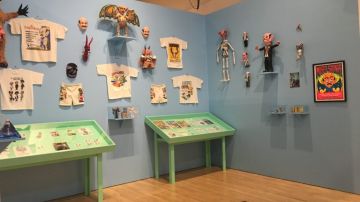Below the Underground: Renegade Art and Action in 1990’s Mexico
For Mexico the 90’s were tumultuous – it marked the rise of the drug cartels, the privatization of the public sector, the North American Trade Agreement, and open widespread government corruption

Photo: Courtesy of Pacific Standard Time, "Museo Salinas" by Vicente Razo 1996
For Mexico the 90’s were tumultuous – it marked the rise of the drug cartels, the privatization of the public sector, the North American Trade Agreement, and open widespread government corruption. Artists were dealing with the loss of the utopian dream and the rejection of neoliberal policy as Mexico slid further and further into social and economic instability.
The exhibit Below the Underground: Renegade Art and Action in 1990’s Mexico is 26 artists’ response to the times through experimental and sometimes shocking emerging artistic practices. The exhibit itself sets the scene for these unconventional works of art by re-creating the experiences of performance art through posters, zines, books, photos, video tapes, music, government recordings, maps, sketches, clothes, and mannequins. To say mixed and/or multimedia would be an understatement, they really “set the stage” so to speak because the art must be experienced in order to have its intended impact.

Renegade Art creates fully immersive vignettes – it’s almost like a movie set where every corner is a different stage. There is video on loop nearly everywhere via projections or with old square TV’s stacked on one another or facing the ceiling. There are small dark rooms (some of which look like hallways) playing films with scattered crates for seating. There are entire scaffoldings built and elevated with various maps, photos and strings. There are piñatas in the likeness of former Mexican president Carlos Salinas De Gortari (not in a flattering way) who reportedly stole $300 million from the Mexican government and devalued the peso. There is an entire room plastered with flyers and album covers as well as various intimate seating areas that are either staged for viewing or to be interacted with.

One of my favorites included “If She Is Mexico, Who Beat Her Up?” by Lorena Wolffer. It is set up like a photoshoot complete with clothes on racks and large photos of bruised models, which are used as a visual metaphor for the economic abuse Mexico endured.

Another personal favorite was the photographs of Ema Villanueva’s public performances. She used the objectification of the female form to bring attention to the political problems of the times. She protested the Mexican government’s violent treatment of students who opposed tuition hikes in 1999 by walking in a bikini through the streets of Mexico City and allowed people to paint their opinions of her directly on her body.

And of course the photographs of artist collective SEMEFO, which are shocking to say the least. They used death in their art as a function of the government power, creating performances that often utilized animal corpses – they actually made a carousel with dead horses. None of their “pieces” survived the test of time because of decay but the images are on another level.
Everything in this exhibit is just slightly askew – offering viewers a reality that is unreal but at the same time too real – making the point that for these artists reality reflected a strange and scary dystopian society. Right now, I think we can all relate.
You can catch the exhibit at the Armory Center for the Arts in Pasadena, California until January 22, 2018.
Exhibiting artists: 19 Concreto, Eduardo Abaroa, Mariana Botey, Casper, Caxa, Andrea Ferreyra, Grupo Incidental, Melquiades Herrera, Jalarte, Marcus Kurtycz, Los Chinos, Los Lichis, Marcelaygina, Teresa Margolles, César Martínez, Sarah Minter, Taniel Morales, Lorena Orozco, Pinto Mi Raya, Vicente Razo/Museo Salinas, Elvira Santamaría, Semefo, Sonido Apokalitzin, Katia Tirado, Ema Villanueva, Lorena Wolffer
Pacific Standard Time: LA/LA is a far-reaching and ambitious exploration of Latin American and Latino art in dialogue with Los Angeles. Led by the Getty, Pacific Standard Time: LA/LA is the latest collaborative effort from arts institutions across Southern California.

















